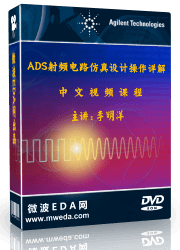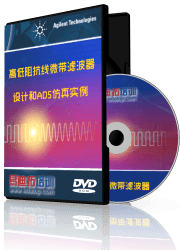- 易迪拓培训,专注于微波、射频、天线设计工程师的培养
How to simulate Insertion Loss of cmos transformer in ADS Momentum
could you help me? many thx
Evaluate S21.
If needed, evaluate S21 in diffential and common modes.
Could you explain how to evaluate transformer's common-mode using Momentum?
For differential-mode, defining differential ports will do the job but how about common-mode.
I am asking this because usually solid ground is not used for transformer; therefore ///GND/// of Momentum should not be used. Also ground reference ports will not lead to accurate results especially if patterned ground shield on the poly layer is used.
This leaves us with no choice but using differential ports. The problem is common-mode could not be evaluated in this case.
Do you have a solution in Momentum?
The problem is getting accurate single-mode S parameters in this case is not possible.
As I explained I have patterned ground shield on poly.
One way is assigning single ports on each terminal of inductor and associating ground reference ports defined on poly layer with these single ports.
But unfortunately aforementioned method is not leading to accurate results. I mean differential S parameters of this case should be same as differential S parameters obtained using differential ports; but unfortunately they are not equal.
I think ground reference ports are working well only on perfect conductor layers.
What is your opinion?
Treat poly layer as signal port not ground reference.
It is a natural result. Consider equivalent circuit for DUT.
Consider that I want to simulate an inductor with a patterned ground shield on poly.
If I assign two single (or internal) ports on every terminal of inductor and another single (or internal) port on poly, then these ports need to have a either implicit (///GND/// in Momentum) or explicit (ground reference ports) ground.
But there will be no ground in this case and as a result S parameters from this three-port network will not have a physical meaning.
It's natural that differential L and Q are not same as L and Q which are obtained from single-mode S parameters. (considering equivalent circuit for DUT as you mentioned)
But if the mixed-mode S parameters are calculated from the single-mode S parameters and then differential L and Q are obtained from these mixed-mode S parameters; differential L and Q should be same though slight discrepancy is acceptable.
I mean either we use one differential port or two single ports, differential L and Q should be same. (in the two single ports case, L and Q are obtained from mixed-mode S parameters and not from single-mode S parameters)
申明:网友回复良莠不齐,仅供参考。如需专业帮助,请学习易迪拓培训专家讲授的ADS视频培训课程。
ADS中文视频培训教程 | More...
 国内最全面、最专业的Agilent ADS培训课程,可以帮助您从零开始,全面系统学习ADS设计应用【More..】
国内最全面、最专业的Agilent ADS培训课程,可以帮助您从零开始,全面系统学习ADS设计应用【More..】
- Agilent ADS教学培训课程套装
- 两周学会ADS2011、ADS2013视频教程
- ADS2012、ADS2013射频电路设计详解
- ADS高低阻抗线微带滤波器设计培训教程
- ADS混频器仿真分析实例视频培训课程
- ADS Momentum电磁仿真设计视频课程
- ADS射频电路与通信系统设计高级培训
- ADS Layout和电磁仿真设计培训视频
- ADS Workspace and Simulators Training Course
- ADS Circuit Simulation Training Course
- ADS Layout and EM Simulation Training Course
- Agilent ADS 内部原版培训教材合集









 沪公网安备 31011202014168号
沪公网安备 31011202014168号
 1427313829
1427313829 旺旺在线
旺旺在线 Skype Online
Skype Online 13761612886
13761612886 官方淘宝店
官方淘宝店
